外科病理学实践:诊断过程的初学者指南 | 第23章 甲状腺(Thyroid)
第23章 甲状腺(Thyroid)
组织学、炎症和非肿瘤性病变(Histology, inflammation and non neoplastic lesions)
The thyroid has two basic cell types: the follicular epithelium (TTF-1 and thyroglobulin positive) and the C cells (TTF-1, neuroendocrine-marker, and calcitonin positive; thyroglobulin negative). Normal follicular epithelium is low cuboidal. The stroma or interstitium is scant but highly vascular.
甲状腺有两种基本细胞类型:(1)滤泡上皮,表达TTF-1和甲状腺球蛋白(TG);(2)C细胞,表达TTF-1、神经内分泌标记物和降钙素,不表达TG。正常滤泡上皮为低立方上皮。间质稀少,血管丰富。
Inflammatory diseases of the thyroid are rarely seen in surgical pathology, with a few exceptions detailed in this chapter. Conceptually, they can be classified by type of response:
甲状腺炎症性疾病在外科病理学中很少见,本章详细介绍了一些例外情况。从概念上讲,它们可以按炎症反应的类型进行分类:
Acute inflammation and necrosis: acute thyroiditis
急性炎症和坏死:急性甲状腺炎
Foreign body giant cells and lymphocytes, diffuse: subacute thyroiditis (de Quervain’s syndrome)
异物巨细胞和淋巴细胞,弥漫性:亚急性甲状腺炎(de Quervain综合征)
Histiocytes, lymphocytes, and rare giant cells, focal: palpation thyroiditis (a reaction to physical trauma, not a primary inflammatory disease)
组织细胞、淋巴细胞和罕见巨细胞,局灶性:触诊性甲状腺炎(对物理创伤的反应,而非原发性炎症性疾病)
Lymphocytic infiltrate with germinal centers: lymphocytic thyroiditis or Hashimoto’s thyroiditis
淋巴细胞浸润伴生发中心:淋巴细胞性甲状腺炎或桥本甲状腺炎
Dense fibrosis and chronic inflammation: sclerosing Hashimoto’s versus fibrosing thyroiditis (Riedel’s, a very rare entity)
致密纤维化和慢性炎症:硬化性桥本病与纤维化性甲状腺炎(Riedel病,一种非常罕见的疾病)
Lymphocytic thyroiditis is a descriptive term implying a generalized lymphocytic infiltrate. The term Hashimoto’s thyroiditis refers to an autoimmune process attacking the thyroid, and it is characterized by the following:
淋巴细胞性甲状腺炎是一个描述性术语,意味着广泛的淋巴细胞浸润。术语桥本甲状腺炎是指攻击甲状腺的自身免疫疾病,其特征如下:
Prominent lymphoplasmacytic infiltrate with germinal center formation (Figure 23.1)
显著的淋巴浆细胞浸润并形成生发中心(图23.1)
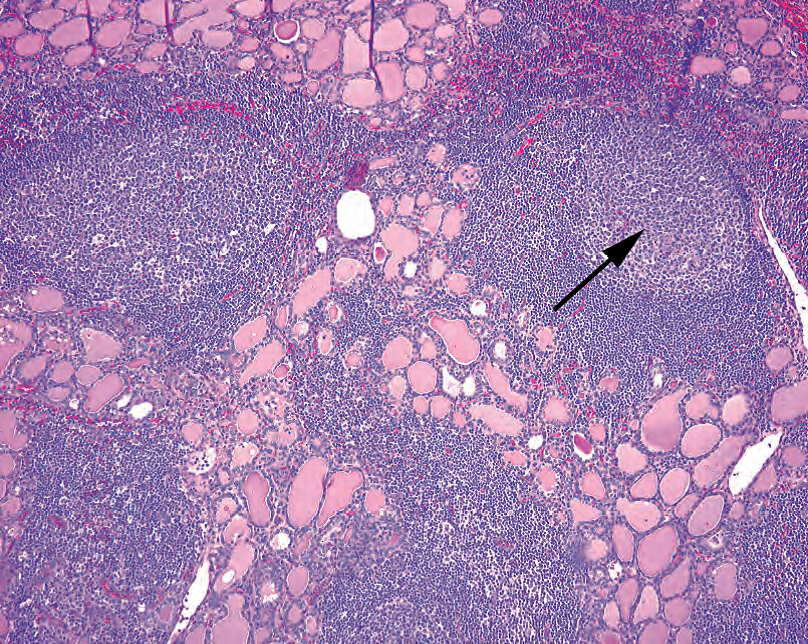
Figure 23.1. Hashimoto’s thyroiditis. The thyroid follicles are displaced by germinal centers (arrow).
图23.1 桥本甲状腺炎。甲状腺滤泡被生发中心取代(箭)。
Small, atrophic follicles with Hürthle cell change (oncocytic change)
小的、萎缩的滤泡,伴Hürthle(许特莱)细胞改变(嗜酸细胞改变)
Scattered nuclear atypia may be seen in this setting, including large hyperchromatic Hürthle cell nuclei, as well as areas of nuclear clearing and pleomorphism that can simulate papillary carcinoma. Therefore, be cautious about diagnosing papillary carcinoma in the setting of lymphocytic thyroiditis. However, these patients can also get papillary carcinoma!
在这种情况下,可以看到散在的核异型性,包括大的深染的Hürthle细胞核,以及可能貌似乳头状癌的核透明和核多形性区域。因此,在淋巴细胞性甲状腺炎背景下诊断乳头状癌应慎重。然而,这些患者也可能真有乳头状癌!
Graves’ disease (diffuse toxic hyperplasia) is a hyperplastic, hyperthyroid condition in which autoantibodies stimulate the thyroid-stimulating hormone receptor to produce excess thyroid hormone. In treated form, more commonly seen in pathology, the follicles are large and distended, with prominent papillary infoldings (Figure 23.2). The papillary architecture can become florid, but the nuclear features are not those of papillary carcinoma (discussed later). Scalloping of the colloid is prominent. In untreated Graves’ disease, on the other hand, the thyroid is highly cellular with minimal colloid.
Graves病(弥漫性毒性增生)是一种增生性甲状腺功能亢进症,自身抗体刺激促甲状腺激素受体产生过量甲状腺激素。病理科较常见治疗后改变,滤泡大而膨胀,有明显的乳头状突起(图23.2)。乳头状结构可能旺炽,但没有乳头状癌的核特征(稍后讨论)。胶体有明显的扇贝形结构。另一方面,未治疗的Graves病,甲状腺高度富于细胞,胶质极少。
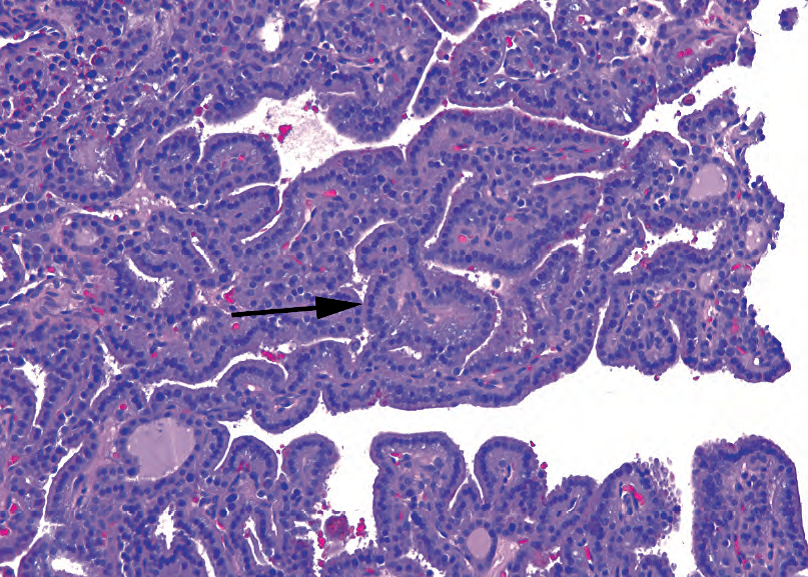
Figure 23.2. Graves’ disease with papillary hyperplasia. These papillary formations are due to hyperplasia of the follicular epithelium. The follicular cells are round, fairly evenly spaced, and have dark uniform chromatin (arrow), similar to normal follicles.
图23.2 Graves病伴乳头状增生。这些乳头状结构是由于滤泡上皮增生所致。滤泡细胞呈圆形,分布相当均匀,染色质深染而均匀(箭),类似于正常滤泡。
Goiter is a nonspecific term for enlargement (hyperplasia) of the thyroid but is often used to refer to the nodular enlargement of the thyroid due to iodine deficiency (endemic goiter) or enzyme defects (sporadic goiter). Multinodular hyperplasia may be sampled by fine-needle aspiration (FNA) if a single nodule becomes dominant and suspicious, or the whole gland may be removed for cosmetic or physiologic reasons. The nodules usually fall on the colloid nodule-to-follicular adenoma spectrum (see later).
甲状腺肿是甲状腺肿大(增生)的非特异性术语,但通常是指由于碘缺乏(地方性甲状腺肿)或酶缺陷(散发性甲状腺肿)引起的甲状腺结节性肿大。如果单个结节占优势且可疑,可通过细针穿刺(FNA)对多结节增生进行取样,或者出于美容或生理原因,可切除整个甲状腺。结节通常位于胶质结节至滤泡性腺瘤的形态学谱系(见下文)。
甲状腺肿瘤(Thyroid neoplasms)
The world of thyroid neoplasms can be broken down into several large categories. The first two categories arise from follicular epithelium, and they are divided in this chapter into two groups based on cytologic and nuclear features. The first category is made up of folliculartype cells that resemble normal thyroid follicular epithelium. This category includes Hürthle cells, which can be found in nonneoplastic thyroid. The second major category is the papillary carcinoma group, of which there are many variants; they have in common a set of diagnostic nuclear features. The third category of neoplasms arises from the neuroendocrine or C cell component of the thyroid; medullary carcinoma is the main entity in this group. Table 23.1 summarizes the architectural and cytologic features of thyroid neoplasms.
甲状腺肿瘤可以分为几个大类。(译注:本章分为三大类:滤泡型病变、乳头状癌和神经内分泌病变)。前两大类起源于滤泡上皮,根据细胞学和核特征分为两组。第一大类由滤泡型细胞组成,类似于正常甲状腺滤泡上皮。这一大类包括Hürthle细胞,可以在非肿瘤性甲状腺中发现。第二大类是乳头状癌组,其中有许多变异型;它们有共同的诊断性核特征。第三大类起源于甲状腺的神经内分泌或C细胞成分;髓样癌是本组的主要实体。表23.1总结了甲状腺肿瘤的结构和细胞学特征。
Table 23.1. Summary of architectural and cytologic features of thyroid neoplasms.
表23.1 甲状腺肿瘤的结构和细胞学特征总结。

滤泡型病变(Follicular-Type Lesions)
Follicular-type cells are notable for their uniformity. The nuclei tend to be round and monotonous, although they may be enlarged compared with normal thyroid. The overall impression is that of a regular array of cells, without crowded, overlapping, or irregular nuclei (Figure 23.3). The cells should respect each others’ personal space, so to speak. The chromatin should be even and smooth, not cleared out, coarse, or chunky.
滤泡型细胞呈现明显的均质性。核往往呈单调的圆形,尽管核可能比正常甲状腺增大。总体印象是细胞排列规则,不拥挤,不重叠,没有不规则核(图23.3)。可以说,细胞懂得尊重彼此的个人空间。染色质应均匀、光滑,不是透明的、粗糙的或粗块状。
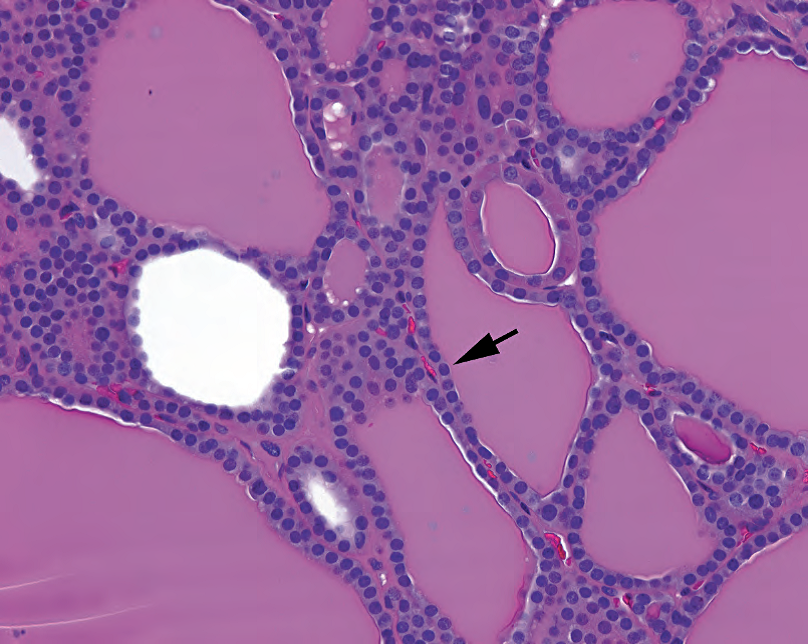
Figure 23.3. Follicular cells. Normal follicular epithelium has round uniform nuclei that tend not to overlap or crowd each other (arrow). This field is a combination of large and small follicles full of colloid and could represent normal thyroid, nodular hyperplasia, or a follicular neoplasm.
图23.3 滤泡细胞。正常滤泡上皮具有圆形均匀的细胞核,一般不重叠、不拥挤(箭)。图示充满胶质的大滤泡和小滤泡的组合,可能代表正常甲状腺、结节性增生或滤泡性肿瘤。
Colloid nodule, adenomatoid nodule, and follicular adenoma all describe a spectrum of hyperplastic to neoplastic lesions composed of a nodular cluster of follicular epithelium. This area is somewhat confusing as the same lesion may get different names depending on whether it is seen by FNA or on resection. A colloid nodule is a hyperplastic nodule of large distended follicles in which the ratio of colloid to cells is high (a key finding on FNA). A follicular adenoma is defined as a solitary encapsulated nodule with compression of the surrounding thyroid and is usually composed of small microfollicles with scant colloid (a low colloid to cell ratio; Figure 23.4). This lesion, seen on FNA, is called a follicular neoplasm, as follicular adenoma and carcinoma can not be distinguished by FNA alone. Finally, there is the adenomatoid nodule, a hyperplastic lesion that has some features of the adenoma.
胶质结节、腺瘤样结节和滤泡性腺瘤都是描述一组由滤泡上皮形成的结节状簇集所形成的增生性至肿瘤性病变的形态学谱系。这些内容有点混乱,因为同一个病灶可能会根据FNA或切除标本的不同而有不同的名称。胶质结节是一种增生性结节,由大的扩张滤泡组成,其中胶质与细胞的比例很高(FNA的一个关键发现)。滤泡性腺瘤是一种孤立的有包膜的结节,周围甲状腺受挤压,通常由小的微滤泡组成,胶质稀少(胶质与细胞比例低,图23.4)。FNA看到的这种病变称为滤泡性肿瘤,因为FNA无法区分滤泡性腺瘤和癌。最后是腺瘤样结节,一种增生性病变,具有腺瘤的部分特征。
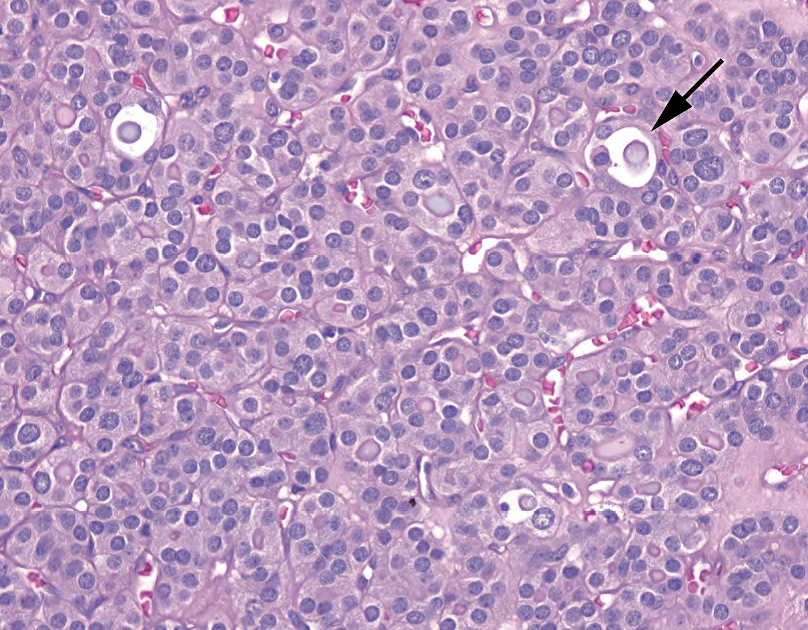
Figure 23.4. Follicular adenoma. This field shows a microfollicular pattern in a follicular adenoma. The capsule is not seen here. The neoplasm is composed of tightly packed small follicles (arrow) with round nuclei that, like normal follicular epithelium (see Figure 23.3), tend not to overlap or crowd. There are scattered enlarged nuclei, some with pale chromatin that should not be mistaken for true nuclear clearing.
图23.4。滤泡性腺瘤。图示滤泡性腺瘤中的微滤泡模式。这里看不到包膜。肿瘤由紧密排列的小滤泡(箭)组成,核圆形,就像正常滤泡(见图23.3),一般不重叠、不拥挤。有散在的增大的核,部分核具有淡染的染色质,不要误认为真正的核透明。
Before calling a lesion a follicular adenoma, however, you must submit and examine the entire capsule. Follicular carcinoma may appear histologically similar to adenoma but for the diagnostic capsular or vascular invasion. This is why you cannot make the distinction by FNA alone. You should also exclude the follicular variant of papillary carcinoma (discussed later).
然而,必需取材并观察整个包膜,才能将病变称为滤泡性腺瘤。滤泡性癌的组织学形态可能类似腺瘤,但有诊断性包膜或血管浸润。这就是FNA不能区分的原因。还应排除滤泡型乳头状癌(稍后讨论)。
Hürthle cell adenoma is very similar to a follicular adenoma in concept except the cells are large pink oncocytes with round nuclei (Hürthle cell change; Figure 23.5). Nucleoli may be prominent, and the nuclei may appear very enlarged or irregular in shape, unlike in follicular adenoma. As with follicular neoplasms, evaluating the capsule is key to calling it benign or malignant.
Hürthle细胞腺瘤在概念上与滤泡性腺瘤非常相似,但细胞为粉红色嗜酸性大细胞,核圆形(Hürthle细胞改变;图23.5)。与滤泡性腺瘤不同,核仁可能显著,核可能很大或形状不规则。与滤泡性肿瘤一样,评估包膜是将其称为良性或恶性肿瘤的关键。
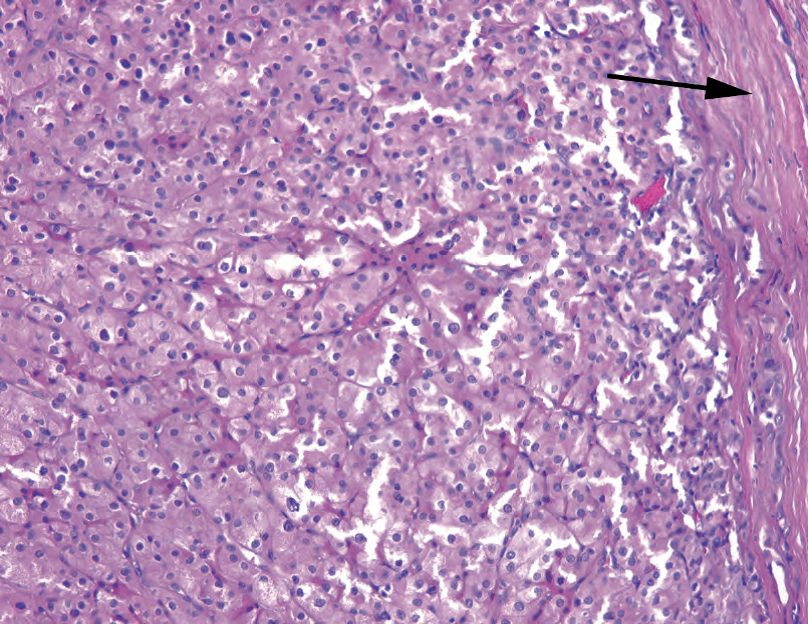
Figure 23.5. Hürthle cell adenoma. Like follicular adenomas, there is a thick fibrous capsule surrounding the neoplasm (arrow). In a Hürthle cell adenoma, the cells have abundant pink cytoplasm, and, although the nuclei are still overall round and nonoverlapping, there is increased nuclear atypia in the form of some prominent nucleoli and irregular nuclear shapes.
图23.5。Hürthle细胞腺瘤。正如滤泡性腺瘤,该肿瘤周围有一层厚厚的纤维包膜(箭)。在Hürthle细胞腺瘤中,细胞有丰富的粉红色细胞质,但总体上核仍然是圆形且不重叠,核非典型性有所增加,表现为有一些明显的核仁和不规则的核形状。
The defining feature of a follicular carcinoma (or Hürthle cell carcinoma) is the presence of capsular or vascular invasion, so examination of the capsule is critical. Atypia and necrosis, while seen in follicular carcinoma, are not sufficient to make the diagnosis.* Capsular invasion is a controversial area, and experts disagree on the exact criteria that define it; however, a mushrooming growth of tumor through the capsule is accepted by most. Vascular invasion must be found within the capsule itself or outside the capsule. The tumor deposit should be visibly attached to the vessel wall (Figure 23.6).
滤泡性癌(或Hürthle细胞癌)的决定性特征是存在包膜或血管浸润,因此检查包膜是至关重要的。非典型性和坏死虽然可见于滤泡性癌,但不足以诊断为滤泡性癌。*包膜侵犯是有争议的领域,专家们对确切的定义标准不一致;然而,大多数人都接受肿瘤呈蘑菇状生长并穿透包膜。血管侵犯必须是发生在包膜内或包膜外。要看到肿瘤沉积物附着在血管壁上(图23.6)。
*Random pearl: In this, the thyroid is like most other neuroendocrine organs, including parathyroid, adrenal, and pituitary. The diagnosis of malignancy is not based on atypia, which can be seen in hyperplastic conditions, but on capsular/vascular invasion or metastases.
*随机红包:这方面,甲状腺与大多数其他神经内分泌器官(包括甲状旁腺、肾上腺和垂体)一样,恶性肿瘤的诊断不是基于异型性(可见于增生性疾病),而是基于包膜/血管浸润或转移。
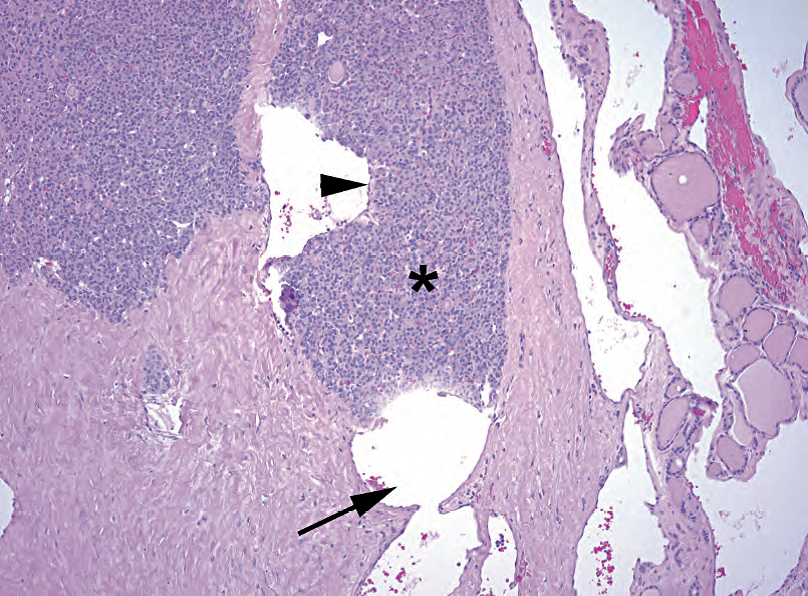
Figure 23.6. Follicular carcinoma. The neoplasm here resembles a follicular adenoma at low power, with a dense microfollicular pattern and a thick capsule. However, there is vascular invasion in the capsule, diagnostic of follicular carcinoma. A tumor plug (asterisk) is seen in the lumen of a large vessel (arrow). The surface of the tumor plug becomes endothelialized (arrowhead).
图23.6。滤泡性癌。该肿瘤在低倍镜下类似于滤泡性腺瘤,具有致密的微滤泡模式和厚包膜。然而,包膜内有血管浸润,这滤泡性癌的诊断性特征。在大血管的管腔(箭)中可以看到瘤栓(星号)。瘤栓的表面有一层内皮(箭头)。
Follicular carcinoma comes in two strengths: minimally invasive (where you have to struggle to find the diagnostic vascular invasion) and widely invasive (where you have to dissect it off the adherent neck structures). It is not associated with radiation or thyroiditis, unlike papillary carcinoma. It spreads via the blood to lung and bone.
滤泡性癌根据浸润程度分两种:微小浸润性(你必须努力找到诊断性血管侵犯)和广泛浸润性(你必须将其从粘附的颈部结构上分离)。与乳头状癌不同,它与辐射或甲状腺炎无关。它通过血液播散到肺和骨。
Insular carcinoma is rarely diagnosed and can be thought of as a poorly differentiated carcinoma. The cells grow in sheets and cords (insular pattern; Figure 23.7) and on high power resemble the round and uniform cells of follicular carcinoma. Pleomorphism is not a typical feature here, but mitoses, necrosis, vascular invasion, and infiltrative growth are common.
岛状癌很少诊断,可视为一种低分化癌。细胞呈片状和条索状生长(岛状模式;图23.7),高倍镜下类似于滤泡性癌的圆形均匀细胞。多形性不是其典型特征,但是常见核分裂、坏死、血管浸润和浸润性生长。
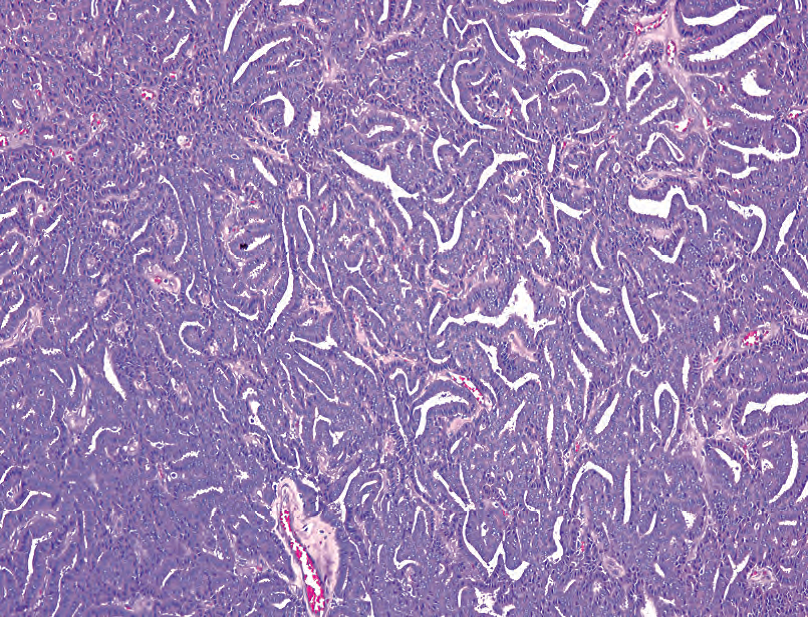
Figure 23.7. Insular carcinoma. Instead of microfollicles, the tumor has acquired a pattern of ribbons, cords, and slit-like spaces.
图23.7 岛状癌。肿瘤形成缎带状、条索状和狭缝状的空隙,而不是微滤泡。
乳头状癌(Papillary Carcinoma)
Papillary carcinoma (there is no papillary adenoma), despite the name, may come with or without the papillae. The diagnosis actually rests on the nuclear features, which are consistent across variant types. The nuclear features are as follows:
乳头状癌(没有乳头状腺瘤),尽管名为“乳头”,实际上可以没有乳头。诊断实际上取决于核特征,这些特征在不同变异型中是一致的。其核特征如下:
Chromatin is cleared out (resembling orphan Annie eyes). This imparts a characteristic low-power look to the lesion; the cells stand out as crisp and pale, almost glittery or glassy (Figure 23.8). It is an artifact of formalin.
染色质透明(像孤儿安妮的眼睛)。使得病变在低倍镜下呈现特征性外观;细胞鲜明而淡染,似乎闪闪发光或毛玻璃样(图23.8)。这是福尔马林固定造成的假象。

(译注:插图,Little Orphan Annie,小孤儿安妮,卡通人物,空洞无神的双眼)
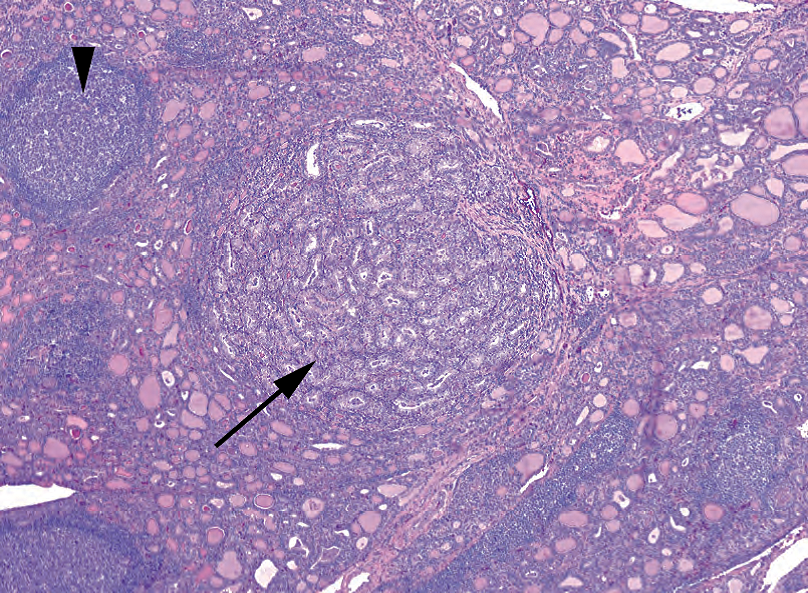
Figure 23.8. Papillary carcinoma, low power. The nuclear features of papillary carcinoma are eyecatching even at low power, as the clear nuclei give a translucent or glassy appearance to the tumor nodule (arrow). This is an example of an incidental microcarcinoma, arising in Hashimoto’s thyroiditis (note germinal centers, arrowhead).
图23.8 乳头状癌,低倍。乳头状癌的核特征即使在低倍镜下也引人注目,因为核透明,使肿瘤结节呈现半透明或毛玻璃样(箭)。这是一例偶然发生的微小癌,发生于桥本甲状腺炎背景中(注意生发中心,箭头)。
Nuclei are overlapping, crowded, and pleomorphic. They often appear boxy and angular at higher power, and you get the impression that too many nuclei have been stuffed into a single row (Figure 23.9); some are squeezed up and out of the row.
核重叠,拥挤,多形性。高倍,核通常呈方形和成角,给人的印象是太多核被挤成一排(图23.9);有些核被挤到外面。
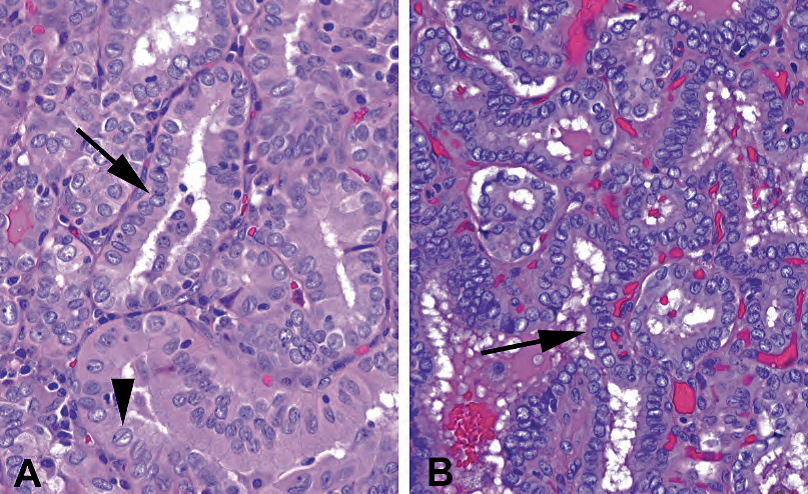
Figure 23.9. Papillary nuclei. (A) In this example, although the nuclear clearing is not striking, the presence of oval nuclei crowded into a row (arrow) suggests papillary carcinoma, as does the presence of nuclear grooves (arrowhead). Compare these nuclei to those of follicular epithelium see (Figure 23.3). (B) In this lesion the nuclear clearing is much more evident. However, the nuclei are still oval in shape and crammed together such that they mold to each other, popping up and out of their crowded rows (arrow).
图23.9 乳头状癌核特征。(A)本例,尽管核透明不那么显著,但卵圆形核挤成一排(箭)提示乳头状癌,核沟(箭头)也提示乳头状癌。将这些核与滤泡上皮核进行比较(见图23.3)。(B)这例核透明更加明显。然而,核仍然是椭圆形,挤在一起,使它们相互镶嵌,有些核被挤到外面(箭头)。
Nuclear grooves (having a coffee bean appearance) are present.
核沟(咖啡豆样)。
Nuclear pseudoinclusions (basically indentations of cytoplasm) are present.
核内假包涵体(主要是细胞质的内卷)。
Note that prominent nucleoli are not a feature of papillary carcinoma. Psammoma bodies are fairly specific for papillary carcinoma but are generally seen only in the context of papillary architecture. True psammoma bodies are dark purple, ringed like a tree, and usually found in the interstitium, not in follicles (Figure 23.10). There are several variants of papillary carcinoma.
注意,显著核仁不是乳头状癌的特征。砂粒体对乳头状癌相当特异,但通常仅见于乳头状结构。真正的砂粒体呈深紫色,环状,如树的年轮,通常位于间质中,而不是滤泡中(图23.10)。乳头状癌有几种变异型,如下:
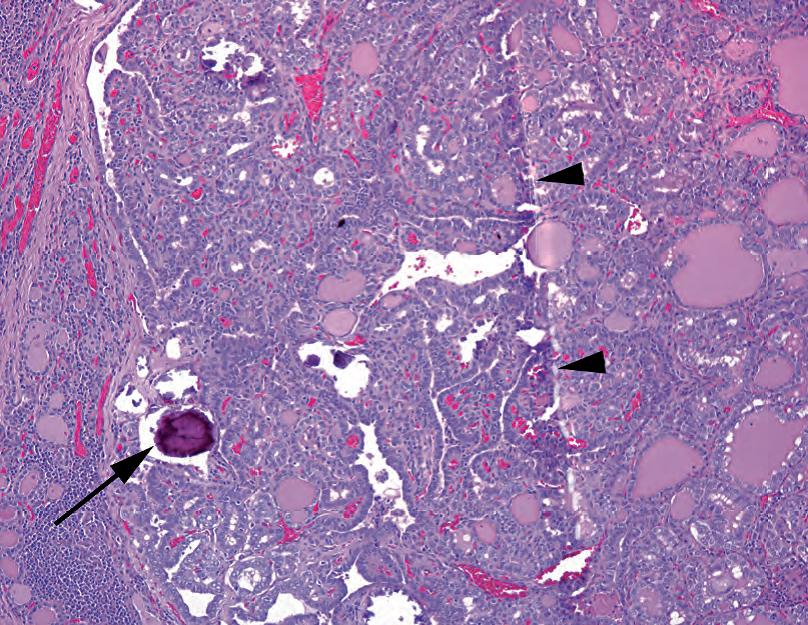
Figure 23.10. Psammoma body. This dense purple laminated calcification (arrow) is virtually diagnostic of papillary thyroid carcinoma in the thyroid or in a neck lymph node. Telltale scratches in the tissue section (arrowheads) often show where a psammoma body was dragged across the block during sectioning.
图23.10 砂粒体。这种致密的紫色层状钙化(箭)几乎是甲状腺或颈部淋巴结中甲状腺乳头状癌的诊断性特征。组织切片(箭头)上的明显划痕通常提示在切片过程中砂粒体被拖过的位置(译注:也可能是砂粒体钙化损伤了刀片,切片时形成了刀痕)。
Papillary microcarcinoma: Although histologically identical to papillary carcinoma, papil-lary microcarcinomas are less than 1 cm (by definition), usually incidentally discovered, and, if solitary, are considered clinically benign.
乳头状微小癌(微小乳头状癌):组织学等同于乳头状癌,直径小于1cm(根据定义),通常是偶然发现,如果是孤立的,则认为临床良性。
Follicular: The follicular variant is a lesion with follicular architecture (no papillae) and papillary nuclei (Figure 23.11). It behaves like a papillary carcinoma and is now signed out as one. Differentiating between a follicular adenoma and a follicular variant of papillary carcinoma is no trivial task, as the nuclear changes can be patchy. Beware fixation artifact (which can produce nuclear clearing but not the other features) and lymphocytic thyroiditis (which produces reactive changes that can simulate papillary nuclei).
滤泡型:具有滤泡结构(无乳头)和乳头状癌核特征(图23.11)。它的生物学行为类似于乳头状癌,现在已认可它是一种癌。区分滤泡性腺瘤和滤泡性乳头状癌并不容易,因为细胞核改变可能是斑片状的。小心固定假象(可产生核透明,但不能产生其他特征)和淋巴细胞性甲状腺炎(可产生可假冒乳头状癌核特征的反应性改变)。

Figure 23.11. Follicular variant of papillary carcinoma. The architecture is that of a follicular adenoma, but the nuclei, oval in shape and crowded together (arrows), are those of papillary carcinoma.
图23.11 滤泡型乳头状癌。其结构正如滤泡性腺瘤,但核呈椭圆形且拥挤(箭),为乳头状癌核特征。
Diffuse sclerosing variant: Although rare, the diffuse sclerosing variant is important to recognize because of its worse prognosis. You can think of this variant as being widely infiltrative in its behavior, as opposed to discrete and mass-forming, and therefore more aggressive. The features include a desmoplastic or sclerotic stroma, squamous metaplasia, psammoma bodies, a dense lymphocytic infiltrate, and vascular invasion.
弥漫硬化型:尽管罕见,但由于预后较差,识别这种亚型很重要。你可以认为这种亚型呈现广泛浸润,而不是形成孤立性肿块,因此侵袭性更强。其特征包括促结缔组织增生性间质或硬化性间质、鳞状化生、砂粒体、密集的淋巴细胞浸润和血管浸润。
Others: Other variants include tall cell, columnar cell, trabecular, cribriform, and cystic variants.
其他:其他亚型包括高细胞型、柱状细胞型、小梁型、筛状型和囊性变异型。
Anaplastic carcinoma is often a papillary carcinoma that has dedifferentiated (Figure 23.12). The tumor cells may appear as sheets of pleomorphic cells (truly undifferentiated), as nonkeratinizing squamous cell carcinoma (squamoid differentiation), or sarcomatoid. A background of papillary carcinoma is not uncommon, but anaplastic carcinoma may arise from other types of carcinoma as well.
间变性癌通常是去分化的乳头状癌(图23.12)。肿瘤细胞可能表现为成片的多形性细胞(真正的未分化)、非角化性鳞状细胞癌(鳞状分化)或肉瘤样细胞。乳头状癌的背景并不少见,但间变性癌也可能起源于其他类型的癌。

Figure 23.12. Anaplastic carcinoma. Nests and sheets of poorly differentiated carcinoma, some areas with a squamoid appearance (arrow).
图23.12。间变性癌。巢状和片状低分化癌,某些区域呈鳞状外观(箭)。
The most important lessons of the papillary variants are these: not all papillary lesions are papillary carcinoma (Graves’ disease, for example), and not all papillary carcinomas have papillary architecture (follicular variant, for example). Also, not all cleared out nuclei are papillary carcinoma. Beware fixation artifact (as discussed earlier), and have a very high threshold of suspicion for papillary carcinoma in the setting of lymphocytic (Hashimoto’s) thyroiditis. A true carcinoma arising in Hashimoto’s thyroiditis should stand out sharply from its neighbors, as in an uninflamed thyroid (see Figure 23.8). Varying degrees of nuclear clearing that come and go across the section are likely to be insignificant.
乳头状病变最重要的教训是:并非所有的乳头状病变都是乳头状癌(例如Graves病),也并非所有的乳头状癌都有乳头状结构(例如滤泡型乳头状癌)。此外,并非所有透明核都是乳头状癌。小心固定假象(如前所述),在淋巴细胞性(桥本)甲状腺炎的背景下,不要轻易诊断乳头状癌。桥本甲状腺炎中,真正的癌应该与相邻组织截然不同,正如无炎症的甲状腺中的癌(见图23.8)。不同程度的核透明在切片中来来往往,可能没有意义。
Papillary carcinomas are associated with radiation and (possibly) thyroiditis as risk factors; unlike follicular carcinoma, they spread to lymph nodes. The prognosis is usually excellent. Age is the most important prognostic factor (younger is better).
乳头状癌可能与放射和(可能)甲状腺炎相关,是危险因素;与滤泡性癌不同,它们扩散到淋巴结。预后通常很好。年龄是最重要的预后因素(年龄越小预后越好)。
神经内分泌病变(Neuroendocrine Lesions)
Medullary carcinoma has features common to other neuroendocrine tumors; the growth may be nested or trabecular, and the cells range from epithelioid to spindled, with uniform finely speckled nuclei (Figure 23.13). At low power, or with poor histology, the sheet-like growth may simulate an anaplastic carcinoma. However, nuclear features or immunohistochemistry should easily tell the difference (calcitonin positivity and thyroglobulin negativity should do it). Medullary carcinomas produce prominent amyloid, which is Congo-red positive.
髓样癌具有其他神经内分泌肿瘤的共同特征;生长方式可以是巢状或小梁状,细胞形态范围从上皮样到梭形,具有均匀细腻的点彩状细胞核(图23.13)。在低倍镜下,或组织学分化较差时,片状生长可能貌似间变性癌。然而,核特征或免疫组织化学应该很容易区分(降钙素阳性和TG阴性)。髓样癌产生显著的淀粉样蛋白,刚果红呈阳性。
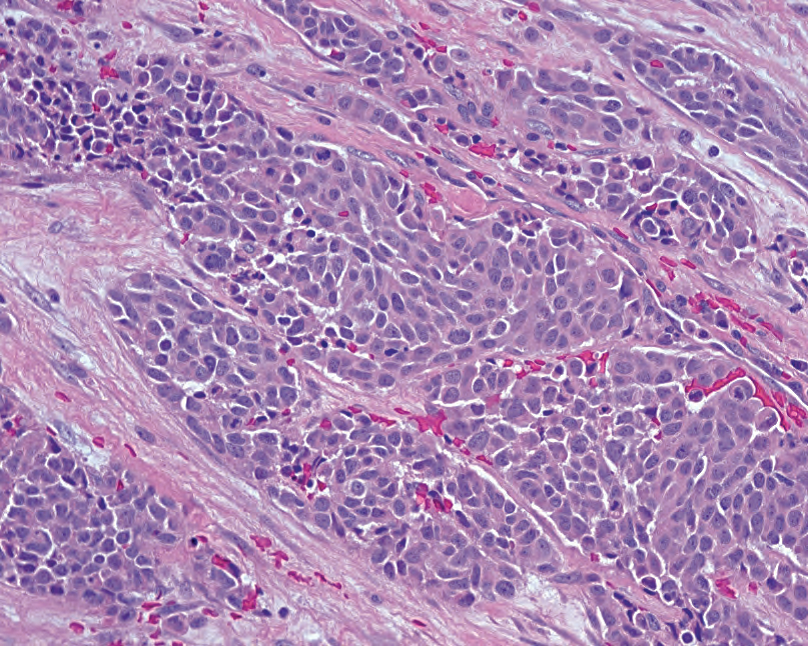
Figure 23.13. Medullary carcinoma. Although the pattern of infiltrative nests of cells may resemble anaplastic carcinoma, the nuclei are much more bland, with pale, finely speckled, neuroendocrine-type chromatin.
图23.13。髓样癌。尽管浸润性细胞巢的生长方式可能类似于间变性癌,但核形态更温和,呈淡染的细腻点彩状神经内分泌型染色质。
颈部囊性非肿瘤性病变(Cystic Nonneoplastic Lesions of the Neck)
While not thyroid lesions, cystic nonneoplastic lesions of the neck are included here as they are commonly seen in surgical pathology and are sometimes mistaken clinically for a thyroid nodule. Such lesions include the following:
虽然不是甲状腺病变,但这里也包括颈部囊性非肿瘤性病变,因为它们在外科病理学中常见,有时临床误认为甲状腺结节。这些病变包括:
Thyroglossal duct cyst: a midline structure (as are the thyroid and the tongue) consisting of a cyst lined by ciliated epithelium and thyroid follicles
甲状舌管囊肿:由纤毛上皮和甲状腺滤泡被覆的囊肿组成的中线结构(如甲状腺和舌)
Branchial cleft cyst: an anterolateral structure (as are the branchial clefts) that looks somewhat tonsillar: squamous, columnar, or ciliated epithelium with a dense underlying lymphocytic infiltrate (not bronchial [i.e., lung] or brachial [i.e., arm])
鳃裂囊肿:一种前外侧结构(如鳃裂),看起来有点像扁桃体:鳞状、柱状或纤毛上皮,下方有密集的淋巴细胞浸润(注意英文拼写,不是支气管[即肺]或臂[即胳膊])
来源:
The Practice of Surgical Pathology:A Beginner’s Guide to the Diagnostic Process
外科病理学实践:诊断过程的初学者指南
Diana Weedman Molavi, MD, PhD
Sinai Hospital, Baltimore, Maryland
ISBN: 978-0-387-74485-8 e-ISBN: 978-0-387-74486-5
Library of Congress Control Number: 2007932936
© 2008 Springer Science+Business Media, LLC
仅供学习交流,不得用于其他任何途径。如有侵权,请联系删除。
本站欢迎原创文章投稿,来稿一经采用稿酬从优,投稿邮箱tougao@ipathology.com.cn
相关阅读
 数据加载中
数据加载中
我要评论

热点导读
-

淋巴瘤诊断中CD30检测那些事(五)
强子 华夏病理2022-06-02 -

【以例学病】肺结节状淋巴组织增生
华夏病理 华夏病理2022-05-31 -

这不是演习-一例穿刺活检的艰难诊断路
强子 华夏病理2022-05-26 -

黏液性血性胸水一例技术处理及诊断经验分享
华夏病理 华夏病理2022-05-25 -

中老年女性,怎么突发喘气困难?低度恶性纤维/肌纤维母细胞性肉瘤一例
华夏病理 华夏病理2022-05-07

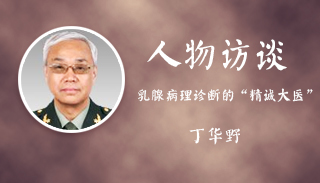





共0条评论